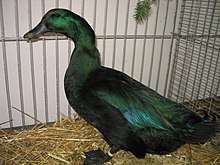Cayuga duck
A Cayuga Duck is a medium-class domesticated duck breed that has been a popular variety in the USA since the mid-19th century. as well as an ornamental bird.
 A Cayuga drake | |
| Country of origin | United States |
|---|---|
| Use | and ornamental |
| Traits | |
| Weight |
|
| Classification | |
| APA | Medium |
| PCGB | Heavy[1] |
| |

History
The Cayuga name is taken from Cayuga Lake, one of the lakes in the Finger Lakes region of New York State, where the breed was popularized. They are black with a green head.
This breed of duck is listed as threatened by the American Livestock Breeds Conservancy.[2]
Characteristics
The Cayuga breed is in the Medium Class and has been a recognized breed of the American Poultry Association since 1874. The standard weight for adult males is 8 lb (3.6 kg) and females 7 lb (3.2 kg). The Cayuga are characterized by a black bill and black plumage, which is an iridescent beetle green in the correct light. In breeding, an emphasis is put on correct coloration, carriage, and a large breast. The Cayuga Duck has dark brown eyes, black shanks, and toes, except in old drakes where some orange shading may appear. Ducklings have black plumage. For exhibition presence of white color in the outer plumage is a disqualification. It is also well liked by many as a great yard pet as they tend to stay close to home.
For those who wish to keep ducks, but live close to others that would make keeping the Pekin breed impractical because of the loud quack, the Cayuga Duck may be an alternative. Its quack is not as loud except the females are quite vocal while often the male is mute. The temperament of the Cayuga is docile, and adult Cayuga Ducks enjoy eating snails, slugs, and most other insects.
The Cayuga Duck will more often sit on and hatch her eggs than other domestic breeds of duck. Incubation for the eggs is 28 days. When using an incubator the temperature should be 99.5 °F (37.5 °C) at 50-70% humidity for days 1–25, and 99.1 °F (37.3 °C) at 70-90% humidity for days 26–28.
See also
References
- "Ducks: Heavy". The Poultry Club of Great Britain. Archived from the original on 14 November 2014. Retrieved 5 November 2014.
- "American Livestock Breeds Conservancy Watchlist". Retrieved 2008-03-25.
External links
| Wikimedia Commons has media related to Cayuga duck. |